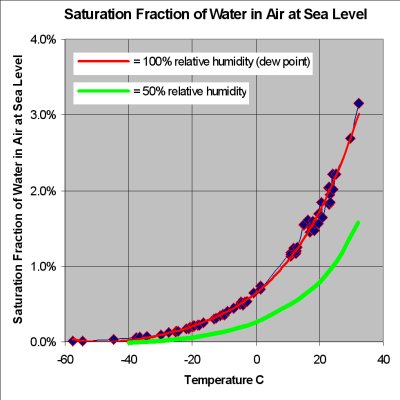Relative humidity
Relative humidity is the ratio of the current vapor pressure of water in any gas (especially air) to the equilibrium vapor pressure, at which the gas is called saturated at the current temperature, expressed as a percentage. Equivalently, it is the ratio of the current mass of water per volume of gas and the mass per volume of a saturated gas.
The numerators of these ratios are the two ways of expressing absolute humidity. The following graph compares dew point (maximum humidity in red) to 50% relative humidity (green line halfway between zero and the dew point across the range of temperatures).
A gas in this context is referred to as saturated when the vapor pressure of water is at the equilibrium vapor pressure for water vapor; liquid water (and ice, at the appropriate temperature) will fail to lose mass through evaporation when exposed to saturated air. It also corresponds to the possibilility of dew or fog forming, within a space that lacks temperature differences among its portions, for instance in response to decreasing temperature. Fog consists of droplets of liquid. (Even though these droplets may be so small as to fall imperceptibly slowly through the mixed gas we call air, this behavior is too different from that of water vapor to reflect it in the same scale. This explains the restriction of relative-humidity discussions to 100% and below.)
The statement that relative humidity can never be above 100%, while a fairly good guide, is not absolutely accurate, without a more sophisticated definition of humidity than the one given here. An arguable exception is the Wilson cloud chamber which uses, in nuclear physics experiments, an extremely brief state of "supersaturation" to accomplish its function.
For a given dewpoint and its corresponding absolute humidity, the relative humidity will change inversely with the temperature. This is because the partial pressure of water increases with temperature – the principle behind everything from hair dryers to dehumidifiers.
Due to this changing partial pressure of water vapor in air as temperature changes, the water content of air at sea level can get as high as 3% at 30 °C (86 °F), and no more than about 0.5% at 0 °C (32 °F). This explains the low levels (in the absence of measures to add moisture) of humidity in heated structures during winter, reflected by dry skin, itchy eyes, and persistence of static electric charges. Even with saturation (100% humidity) outdoors, heating of whatever outside air comes indoors raises its moisture capacity, reflected in decreased relative humidity and increased evaporation rates from moist surfaces.
Similarly, during summer in humid climates a great deal of water condenses from air cooled in air conditioners. Warmer air is cooled below its dewpoint and that water condenses. This phenomenon is the same as that which causes the outside of a cup containing an ice-cold drink to get wet.
Water vapor is a lighter gas than dry air, so humid air will tend to rise through drier air at the same temperature. This phenomemon is a mechanism behind thunderstorms, since as the humid rising air also becomes colder as it rises due to adiabatic cooling, and as the air cools past its dew point, water vapor condenses into small droplets(cloud may thus form),which will further condense into larger water droplets,if certain conditions are met,for example,small particles(seeds).Should they become too large for warm air to lift,they will fall down as rain.
Relative humidity is often mentioned in weather forecasts and reports, as it is an indicator of the likelihood of precipitation, dew, or fog. In hot summer weather, it also increases the apparent temperature to humans (and other animals) by preventing the evaporation of perspiration from the skin. This effect is calculated in a table, resulting in the heat index or humidex.
A device used to measure humidity is called a hygrometer, one used to regulate it is called a humidistat, or sometimes hygrostat. (These are analogous to a thermometer and thermostat for temperature, respectively.)

